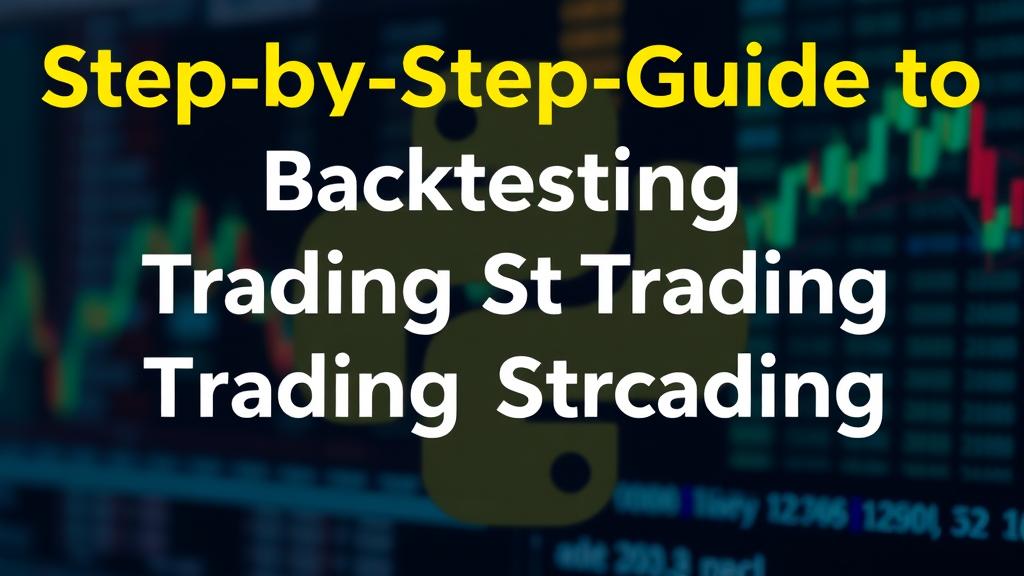Inviting Exploration of Advanced Strategies
Curious about how advanced algorithms are influencing investment strategies? Let’s dive into the mechanics of modern trading.
Step-by-Step Guide to Backtesting Trading Strategies Using Python
In the world of trading, the difference between success and failure often hinges on the ability to test and refine strategies before risking real money. Backtesting, the process of testing a trading strategy on historical data, is essential for traders seeking to understand potential performance. With the rise of technology, Python has emerged as a powerful tool for backtesting trading strategies. This article provides a comprehensive, step-by-step guide to backtesting trading strategies using Python, ensuring you have the right tools and knowledge to make informed trading decisions.
Before diving into the technical aspects, it’s essential to grasp what backtesting is and why it is crucial in trading.
What is Backtesting?
Backtesting is the process of simulating a trading strategy using historical market data to evaluate its performance. By applying a trading strategy to past price movements, traders can assess how the strategy would have performed in the past.
Why Backtest?
Backtesting is vital for several reasons:
- Risk Management**: Identify potential losses before implementing a strategy.
- Strategy Validation**: Verify whether a strategy is effective and worth pursuing.
- Performance Metrics**: Understand various metrics such as return on investment (ROI) and drawdown.
- Refinement**: Adjust strategies based on historical performance to enhance future results.
Setting Up Your Python Environment
To start backtesting trading strategies, you need to set up a Python environment. Here’s a step-by-step guide to get you started.
1. Install Python
If you haven’t installed Python yet, download it from the official [Python website](https://www.python.org/downloads/), and follow the installation instructions. Ensure to add Python to your system path.
2. Install Required Libraries
You’ll need several libraries to facilitate data manipulation, backtesting, and visualization:
- Pandas**: For data manipulation.
- NumPy**: For numerical operations.
- Matplotlib**: For data visualization.
- Backtrader**: A popular backtesting library for Python.
You can install these libraries using pip:
bash pip install pandas numpy matplotlib backtrader
Acquiring Historical Data
Once your environment is set up, the next step is acquiring historical data. This data is crucial for backtesting as it forms the foundation upon which your strategies will be tested.
Sources of Historical Data
You can obtain historical data from various sources. Here are some popular options:
- Yahoo Finance**: Offers free historical stock data.
- Alpha Vantage**: Provides free APIs for historical market data.
- Quandl**: A platform for financial, economic, and alternative datasets.
Example: Downloading Data from Yahoo Finance
You can use the `yfinance` library to download historical data easily. Install it using:
bash pip install yfinance
Then, you can download data as follows:
python import yfinance as yf
Download historical data for Apple stock data = yf.download(‘AAPL’, start=’2020-01-01′, end=’2023-01-01′) print(data.head())
Developing a Trading Strategy
Now that you have your data, it’s time to develop a trading strategy. A simple yet effective strategy is the Moving Average Crossover.
What is a Moving Average Crossover?
A Moving Average Crossover strategy involves two moving averages:
- Short-term Moving Average (SMA)**: Reflects recent price movements.
- Long-term Moving Average (LMA)**: Smooths out price data over a more extended period.
How the Strategy Works
- Buy Signal**: When the Short-term Moving Average crosses above the Long-term Moving Average.
- Sell Signal**: When the Short-term Moving Average crosses below the Long-term Moving Average.
Implementing the Strategy in Python
Here’s how to implement the Moving Average Crossover strategy using Python:
python import backtrader as bt
class MovingAverageCrossover(bt.Strategy): def __init__(self): self.short_ma = bt.indicators.SimpleMovingAverage(self.data.close, period=10) self.long_ma = bt.indicators.SimpleMovingAverage(self.data.close, period=30)
def next(self): if self.short_ma > self.long_ma: self.buy() elif self.short_ma < self.long_ma: self.sell()
Backtesting the Strategy
With your strategy implemented, it’s time to backtest it using historical data. Here’s how to carry out the backtesting process.
1. Create a Cerebro Instance
Cerebro is the core engine of Backtrader. It coordinates the data feeds, strategy execution, and performance metrics.
python cerebro = bt.Cerebro()
2. Add Data to Cerebro
You need to feed the historical data into the Cerebro engine.
python data_feed = bt.feeds.PandasData(dataname=data) cerebro.adddata(data_feed)
3. Add the Strategy to Cerebro
Now, add the Moving Average Crossover strategy to Cerebro.
python cerebro.addstrategy(MovingAverageCrossover)
4. Run the Backtest
Finally, run the backtest and visualize the results.
python cerebro.run() cerebro.plot()
Analyzing Results
After running the backtest, it’s crucial to analyze the results to understand the performance of your strategy.
Performance Metrics to Consider
- Total Return**: The overall return of the strategy.
- Annualized Return**: The return adjusted for the duration of the investment.
- Maximum Drawdown**: The largest drop from a peak to a trough, indicating risk.
- Sharpe Ratio**: A measure of risk-adjusted return.
Example Code for Performance Analysis
You can access performance metrics directly from the Cerebro instance:
python print(‘Final Portfolio Value: %.2f’ % cerebro.broker.getvalue())
Conclusion
Backtesting trading strategies using Python is a powerful way to validate your trading ideas without risking real capital. By following this step-by-step guide, you can set up your environment, acquire historical data, develop your trading strategy, conduct a backtest, and analyze the results.
Remember, while backtesting can provide valuable insights, it’s essential to approach trading with caution. No strategy is foolproof; thus, continuous learning, refining, and adjusting your strategies are crucial as market conditions change.
With the right tools and knowledge at your disposal, you are now better equipped to evaluate and implement effective trading strategies, paving the way for informed and confident trading decisions. Happy trading!



